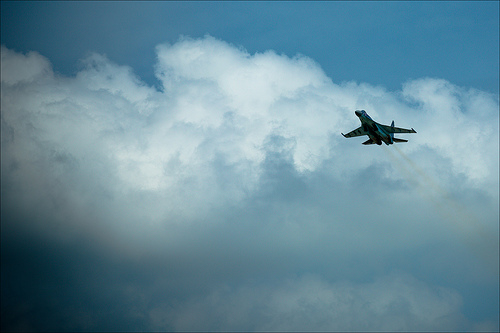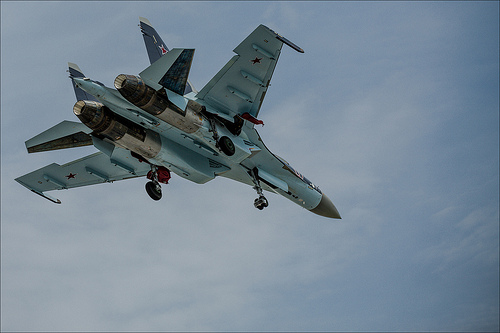Check out these china prototype business images:
Flanker Plus

Image by Fotografik33 – www.fotografik33.com
www.fotografik33.com
Démonstration du Soukhoi Su 35 au salon du Bourget.
Le Soukhoï Su-35 (Flanker Plus dans le code OTAN) est un chasseur russe. Il a été créé dans le but d’accroître les capacités offensives du Su-27 et de lui donner la possibilité de détruire tant les cibles aériennes que de surface.
Le Su-35 est le premier chasseur au monde à avoir deux radars, un N-011 multimode à balayage électronique à l’avant et un N-012 dans le cône de queue. Le N-011 est capable d’acquérir 15 cibles et d’en engager eight, sa portée est de plus de one hundred km pour un objectif d’une SER de ,01 m2.
Sukhoi Su35 demonstration at Paris Air Show "Le Bourget".
The Sukhoi Su-35 (Russian: Сухой Су-35 NATO reporting name: Flanker-E) is designation of two different heavily-upgraded derivatives of the Su-27 ‘Flanker’. Each are single-seat, twin-engine supermaneuverable multirole fighters, developed by Sukhoi and constructed by Komsomolsk-on-Amur Aircraft Production Association (KnAAPO).
The very first variant was made throughout the 1980s, when Sukhoi was looking to upgrade its higher-overall performance Su-27, and was initially recognized as the Su-27M. Later re-designated Su-35, this derivative incorporates aerodynamic refinements to boost manoeuvrability, enhanced avionics, longer range, and a much more powerful engine. The first Su-35 prototype, converted from a Su-27, produced its maiden flight in June 1988. Much more than a dozen of these have been built with some utilized by the Russian Knights aerobatic demonstration group. The initial Su-35 style was later modified into the Su-37 with thrust-vectoring engines and used as a technologies demonstrator. A sole Su-35UB two-seat trainer was built in the late 1990s that, despite its name, shares a robust resemblance to the Su-30MK family members.
In 2003, Sukhoi embarked on a second modernization of the Su-27 to produce what the company calls a four++ generation fighter that would serve as an interim fighter prior to the arrival of the Sukhoi PAK FA. This derivative incorporates a reinforced airframe, enhanced avionics and radar, thrust-vectoring engines, and a reduced radar signature from the front, although omitting the canards and air brake. In 2008 the revamped variant, erroneously dubbed the Su-35BM by the media, began its flight test programme that involved 4 prototypes, one of which was lost in 2009.
The Russian Air Force has ordered 48 production units, designated Su-35S, of the newly-revamped Su-35. Each Su-35 models have been offered to many countries, such as Brazil, China, India and South Korea, but so far have not attracted any export orders. Sukhoi originally projected that it would export far more than 160 units of the second modernized Su-35 worldwide.
Flanker Plus variation1

Image by Fotografik33 – www.fotografik33.com
www.fotografik33.com
Démonstration du Soukhoi Su 35 au salon du Bourget.
Le Soukhoï Su-35 (Flanker Plus dans le code OTAN) est un chasseur russe. Il a été créé dans le but d’accroître les capacités offensives du Su-27 et de lui donner la possibilité de détruire tant les cibles aériennes que de surface.
Le Su-35 est le premier chasseur au monde à avoir deux radars, un N-011 multimode à balayage électronique à l’avant et un N-012 dans le cône de queue. Le N-011 est capable d’acquérir 15 cibles et d’en engager 8, sa portée est de plus de 100 km pour un objectif d’une SER de ,01 m2.
Sukhoi Su35 demonstration at Paris Air Show "Le Bourget".
The Sukhoi Su-35 (Russian: Сухой Су-35 NATO reporting name: Flanker-E) is designation of two different heavily-upgraded derivatives of the Su-27 ‘Flanker’. Both are single-seat, twin-engine supermaneuverable multirole fighters, created by Sukhoi and built by Komsomolsk-on-Amur Aircraft Production Association (KnAAPO).
The 1st variant was created for the duration of the 1980s, when Sukhoi was hunting to upgrade its higher-functionality Su-27, and was initially identified as the Su-27M. Later re-designated Su-35, this derivative incorporates aerodynamic refinements to increase manoeuvrability, enhanced avionics, longer range, and a much more effective engine. The 1st Su-35 prototype, converted from a Su-27, created its maiden flight in June 1988. Far more than a dozen of these were constructed with some utilized by the Russian Knights aerobatic demonstration team. The very first Su-35 design and style was later modified into the Su-37 with thrust-vectoring engines and employed as a technologies demonstrator. A sole Su-35UB two-seat trainer was constructed in the late 1990s that, regardless of its name, shares a powerful resemblance to the Su-30MK household.
In 2003, Sukhoi embarked on a second modernization of the Su-27 to generate what the business calls a four++ generation fighter that would serve as an interim fighter prior to the arrival of the Sukhoi PAK FA. This derivative incorporates a reinforced airframe, enhanced avionics and radar, thrust-vectoring engines, and a lowered radar signature from the front, even though omitting the canards and air brake. In 2008 the revamped variant, erroneously dubbed the Su-35BM by the media, started its flight test programme that involved four prototypes, one of which was lost in 2009.
The Russian Air Force has ordered 48 production units, designated Su-35S, of the newly-revamped Su-35. Both Su-35 models have been provided to many nations, which includes Brazil, China, India and South Korea, but so far have not attracted any export orders. Sukhoi originally projected that it would export far more than 160 units of the second modernized Su-35 worldwide.